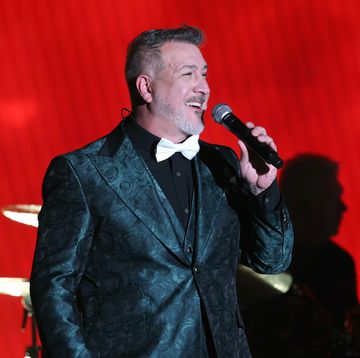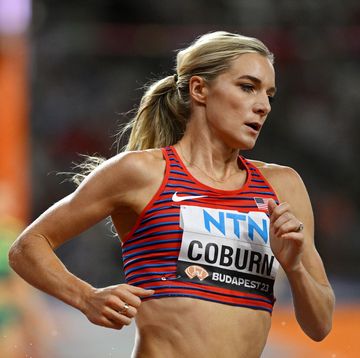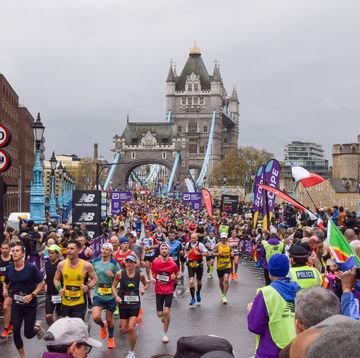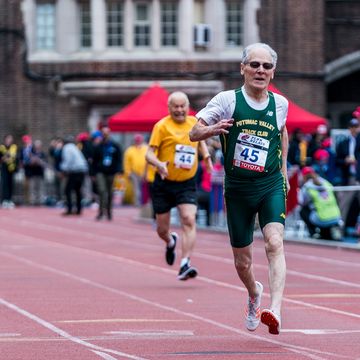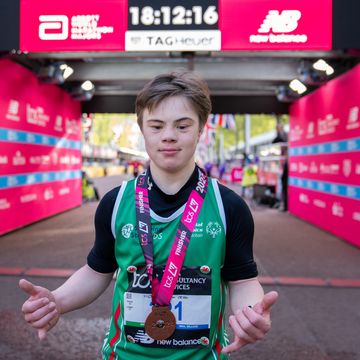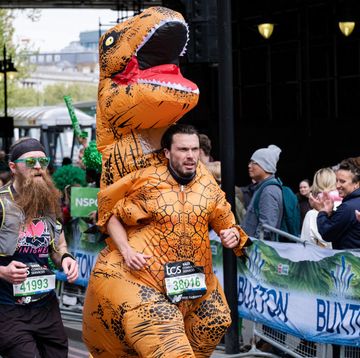At 3:06 p.m. last Friday, Finland’s Ashprihanal Aalto, 44, won the world’s longest certified footrace in the fastest time in the event's history. Aalto completed the Self-Transcendence 3,100-Mile Race, in Jamaica, Queens, in 40 days, nine hours, six minutes, and 21 seconds, an average of just more than 76.75 miles per day. He broke Madhupran Wolfgang Schwerk’s 9-year-old record, which some thought would never be broken, by more than 23 hours.
To a casual observer walking by the New York City block where the race takes place, the event might, at first, look like some people just out for a run. But since June 14, the race’s 12 competitors—10 men, two women—have been running for 18 hours a day around the sidewalks that circle a high school and baseball field.
The event’s competitors have 52 days, until August 4, to complete 3100.17 miles, an average of 59.6 miles per day. In the previous 18 years of the event, 37 different people have finished the race a total of 133 times. This year, that total could rise to 39 unique finishers recording 140 finishes. (Read more about the event's history here.)
The race begins promptly at 6:00 each morning, and competitors cover as many laps, just more than half a mile each, as they can before the race ends for the day at midnight. Anyone who doesn’t have a place to stay in the area is driven to nearby apartments, rented specifically for the race, where they get as much sleep as one can get in less than six hours.
Aalto says that in this year’s winning effort, four hours, 45 minutes of sleep was the most he ever got, and sometimes he got less, especially in the beginning when “[my] mind was not falling asleep.”
As the race progressed, Aalto began to appreciate the 10-minute naps he took during his three 12- to 15-minute breaks each day, and found that he could fall into a deep sleep almost instantly.
RELATED: WHAT IT TAKES TO ENDURE THE WORLD'S LONGEST RACE
Most of Aalto’s competitors still have days of running remaining. His closest competitor, Galya Balatskyy of Ukraine, finished more than two days after Aalto, on Sunday night. As of Monday evening, the top woman, Austria’s Surasa Mairer, was on pace to stress the women’s course record, held by Suprabha Beckjord of the United States, by about half a day.
The race course may appear to be nothing special to an outside observer, but it has become special to the race’s participants, who travel from all over to take part in the event. Though it is not a prerequisite for participation, most of the event’s competitors are followers of the late Sri Chinmoy, a spiritual teacher who founded the race and encouraged going beyond perceived personal limits to reach new levels of inner and outer perfection.
Chinmoy lived about a mile from the race course, in Queens, until he died in 2007. Many involved with the race knew Chinmoy personally.
Aalto, who has run the race 13 times and won eight times, said of this year’s record-setting victory, “It was like an inner journey also. I felt like [I was] doing it for my spiritual teacher [Chinmoy], in memory of him. He once told me, after I finished my first race here, he said, ‘You can do much, much better, so you come next year and break the record.’ I’m very happy that I was able to do it,” Aalto said.
Aalto admits that when he began running the race as a 29-year-old, he thought maybe he’d run his best time when he was around 35. He didn’t expect to be setting records at 44, but years of running the race have taught him valuable lessons about strategy.
“I used to, in the beginning years of my career, sometimes come to a race already tired and that’s the secret, that you have to learn to take it easy before the race,” Aalto said. “[This year] I used everything I knew from the previous races—which things help me, which things [don’t] help me. It’s a lot in the mind, not to let anything bug me and stand in my way. I just go, go, go, go all the time.”
Aalto says that his training included a few 25-mile runs now and then, but nothing like the mega miles he posts during the race. He says that his work, delivering a daily newspaper back home in Finland, helps him stay fit, and he gets enough vacation from his job that it’s possible for him to attend the race each year.
Though Aalto’s race lasted more than 40 days, every second was important to him in going after the record.
“I even tried going to the toilet kind of quickly,” Aalto said. “At the same time, [I wanted to] feel a balance of not getting stressed. It’s a balance of all the time being focused, the whole summer. Sometimes you almost lose the focus and realize, ‘Oh no, I’m going kind of slowly,’ and then you have to bring it back.”
For the first 10 days of the race, Aalto aimed to run at least 78 miles a day, but as the race stretched on, his minimum became 75 miles. Covering that kind of distance meant rarely stopping. He ate during walking breaks—he estimates that he walked about 100 meters of most laps—or while running.
Shoes & Gear.
“If I got a really nice meal from a nice restaurant once a week, then I could walk a whole lap,” Aalto said.
One of Aalto’s funnier interactions with a passerby came during a prior year’s race.
“I had a bag of chips in my hand and I was running and eating at the same time. This car went by and [someone said] really loudly, ‘You’ve got to be kidding me. You’re out running and eating chips at the same time.’ He thought I was just jogging and eating chips, and that I was crazy.”
The on-the-go eating served Aalto well, however, as he lost only about five pounds during this year’s race. He said that while some people try to gain weight heading into the race, knowing that they’ll lose it, he lost weight in advance of the race, so that he wouldn’t be carrying extra weight from the start.
Keeping the runners fed throughout the race requires a good deal of work by the race organizers. Each year, they rent a double garage about a mile from the course and convert it into a kitchen. Approximately six volunteer cooks prepare meals for the competitors and the handlers who help them throughout the race, and others transport the food to the course.
It takes approximately 100 volunteers each year to support the race’s 12-15 competitors. Sahishnu Szczesiul, one of the event’s four race directors, says that 15 is about as large as the field will get, due to space limitations on the course and the cost of renting apartments. This year, race organizers started with a list of 20-22 interested competitors, and chose 14, plus several alternates, because there are always runners who have to drop out in advance of the race.
The event’s entry fee is $1,250, which doesn’t come close to covering the expenses of one runner. The race relies on donations to cover the rest of its expenses.
But to Chimnoy’s followers, keeping the event going in his name is important, because it’s grown into something special.
“It’s not just a running event,” Szczesiul said. “It’s also a self-exploration, seeing how you deal with adversity, the changing elements, the heavy-duty mileage you have to put up, and the experience of going beyond your present capacity.”
Szczesiul says that having a good relationship with New York City’s Department of Parks and Recreation, as well as the principal of the high school the race circles, has been important in keeping the race going. Some who live and work in the neighborhood have taken an interest in the race, and even know some of the competitors’ names.
As word of Aalto’s impending finish spread on Friday afternoon, a relatively large crowd gathered to watch him break the tape. After a short rest period, he was ushered to a personalized float, attached to a Honda Odyssey. Atop the float, he rode one more lap of the course—a victory lap of sorts.
Since finishing, Aalto has taken some time away from the race course, including a rock climbing outing on Monday, but he is also spending time at the race to help his competitors, running a lap with them here and there, partially because he doesn't think it would be good for his body to stop exercising cold turkey. He will stick around until the end of the race, and spend several more days in the United States before heading back to work in Finland.
Though he still feels a need to catch up on sleep, Aalto is pleased with his body’s recovery and lack of injuries. Because he hopes to climb Mt. McKinley, Aalto doesn’t plan to return to the race next summer, but says he won’t decide for sure for several months. For now, he’s just reveling in this year’s accomplishment.
“This was absolutely my life’s best result by far, my greatest success, so I’m very happy,” Aalto said. “Finally I could do what my potential has been.”



